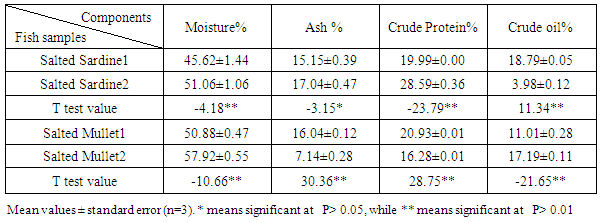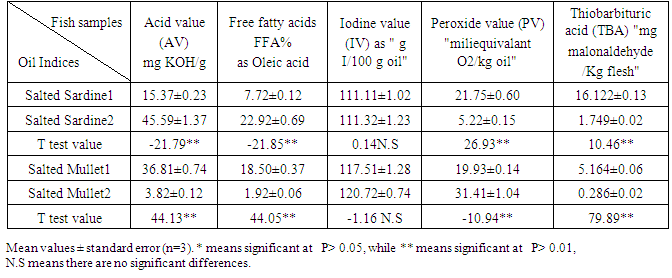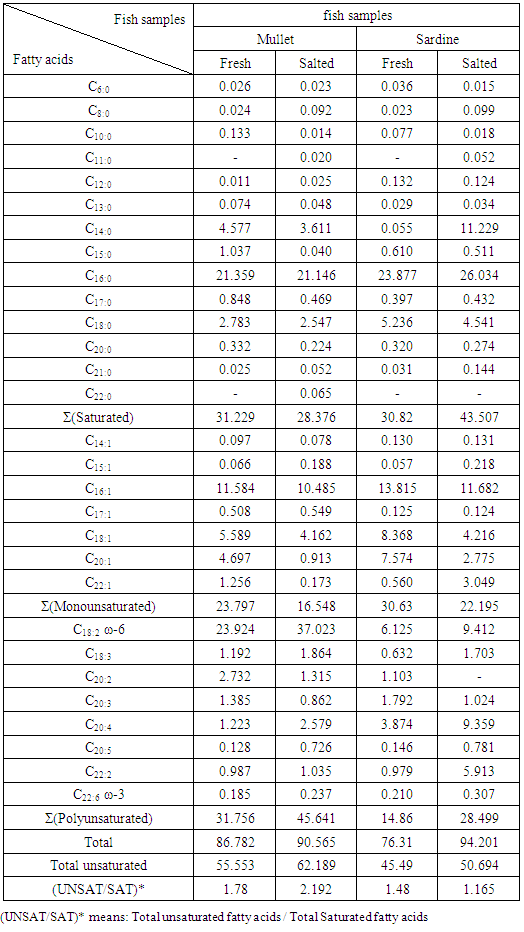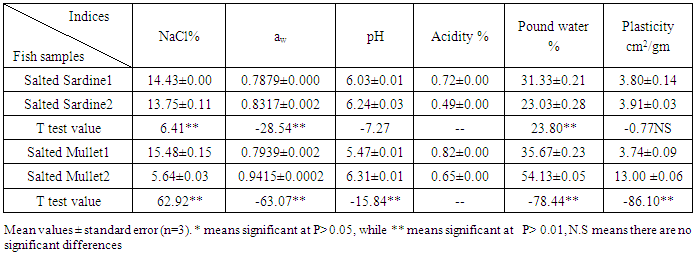-
Paper Information
- Paper Submission
-
Journal Information
- About This Journal
- Editorial Board
- Current Issue
- Archive
- Author Guidelines
- Contact Us
International Journal of Food Science and Nutrition Engineering
p-ISSN: 2166-5168 e-ISSN: 2166-5192
2015; 5(6): 219-225
doi:10.5923/j.food.20150506.01

Sensory, Chemical and Physical Characteristics of Some Traditional Salted Fish Samples from Egyptian Market
Shady M. ElShehawy1, 2, Rezk A. El-Dengawy3, Zeinab S. Farag3
1Food Industries Dept., Fac. of Agric., Mansoura University, Mansoura, Egypt
2Biology Dept., College of Applied Sciences, Umm Al-Qura University, Makkah, KSA
3Food Industries Dept., Fac. of Agric., Damietta University, Damietta, Egypt
Correspondence to: Shady M. ElShehawy, Food Industries Dept., Fac. of Agric., Mansoura University, Mansoura, Egypt.
| Email: |  |
Copyright © 2015 Scientific & Academic Publishing. All Rights Reserved.
This work is licensed under the Creative Commons Attribution International License (CC BY).
http://creativecommons.org/licenses/by/4.0/

There are many types of salted fish in Egypt such as Feseekh (prefermented salted mullet), salted sardine and Meloha. Many cases of food poisoning are occurred caused by these salted products especially in Sham ElNassim festival and Eid Elfetr. So, the purpose of the present study was to get a view of the quality of the prefermented salted mullet and salted sardine sold in the Egyptian market. The different kinds of salted fish samples were collected from local markets in Damietta governorate at the north of Egypt. Sensory evaluation, physical measurements (aw, WHC, pH and plasticity) and chemical analyses (TVN, TSN, NPN, PV, TBA and fatty acids) were determined. The statistical analysis showed that there were highly significant differences at P>0.01 between each couple of salted fish studied in most chemical and physical attributes. As for sensory evaluation, there were significant differences at P>0.05 between the two samples of salted mullet in appearance and colour. Meanwhile, there were significant differences at P>0.05 between the two samples of salted sardine in total score and at P>0.01 in texture and juiciness. Furthermore, fatty acids profile, palmetic acid (C16:0) as a saturated fatty acid came at the first order in both samples, which it represented 21.2% in salted mullet1 and 26.0% in salted sardine1. Linoleic acid C18:2ω-6 represented the highest polyunsaturated fatty acid in salted mullet1, where it was 37.0%. From the obtained results it could be reported that all studied salted fish products were compatible with their standard specifications from chemical and physical view. It could be concluded that there is no documented method to produce such salted products.
Keywords: Sardine, Mullet, Salted fish, Egypt, Sensory evaluation, Fatty acids, Food poisoning
Cite this paper: Shady M. ElShehawy, Rezk A. El-Dengawy, Zeinab S. Farag, Sensory, Chemical and Physical Characteristics of Some Traditional Salted Fish Samples from Egyptian Market, International Journal of Food Science and Nutrition Engineering, Vol. 5 No. 6, 2015, pp. 219-225. doi: 10.5923/j.food.20150506.01.
Article Outline
1. Introduction
- Fish protein is considered one of the sources of animal protein in Egypt, where represented 4.6 g per capita per day rated 21.7% from animal proteins as consumption [12]. The protein of fish muscle is rich in essential amino acids, has a high biological value and can be easily digested. The amount of connective tissue is low (1-2%) compared with warm-blooded animals (10-13%) [23].Gram and Huss (1996) stated that fish are perishable food commodities which generally spoil faster than other muscle foods. The spoilage of fish is a complex process in which physical, chemical and microbiological mechanisms are implicated. Enzymatic and chemical reactions are usually responsible for the initial loss of freshness, whereas microbial activity is responsible for the overt spoilage which thereby establishes product shelf life [13].NaCl is added to foods for its effects on sensory, functional and preservation properties. NaCl inhibits microbial growth by restriction of the available water (i.e. lowers aw) in the meat and fish products. However, its pro-oxidant activity is reported to accelerate the development of lipid oxidation in marinated and salted fatty fish products [3]. Salting is one of the oldest methods for fish preservation. It is based on the penetration of salt into the fish muscle. Nowadays, salting is considered to give specific sensory characteristics to the final product [1, 5, 11].El-Feseekh (Prefermented salted Egyptian fish) produced from one of Mugilidae family items salting to preserve them and to achieve an appropriate degree of aging. Also, to give them the distinctive sensory properties of such product. Dry or wet salting method is used and the products are stored in sealed containers [8]. Mohamed et al. (2009) stated that there are two types of Feseekh in the Egyptian market, the first type having a low salt content and being suitable for consumption after 15-20 days of maturing, while the second has a high salt content and can be eaten after 2-3 months of storage. From the nutritional point of view, Feseekh is a rich source of high quality protein, essential amino acids, vitamins, and minerals [18]. Salted sardines are produced from sardines or like-sardine fish salting to preserve them and to achieve a suitable degree of maturation. Also, to give them distinctive sensory properties of such product without any additional treatments [9].Kuda, et al. (2012) studied salted and fermented fish products which purchased from retail shops in Ishikawa and Fukui, Japan in April 2010. They found that salt percentage of salted sardine and salted mackerel ranged from 7.9-14.5% and 4.9-13.4%, respectively. And they found that pH value of these samples ranged from 4.89-5.60 and 4.68-5.32, respectively [15]. Meanwhile, Nguyen, et al. (2012) reported that moisture, salt content, SFA, MUSFA and PUSFA in brined cod (Gadus morhua) were 78.8%, 10.1%, 21.39%, 21.42% and 50.72%, respectively. But they found these percentages in dry salted cod after 2 months from storage were 59.3%, 22.1%, 23.96%, 22.59% and 47.81%, respectively [20].El-Dengawy, et al. (2012) studied chemical and microbiological characteristics of some salted fish samples. They found that total viable bacterial count, aerobic spore forming bacteria, Staphylococcus aureus, coliform group, Clostridium spp. and anaerobic spore formers producing H2S were studied. They reported that salted fish samples were not compatible with their standards (EOS) from microbiological view, where as it contained Clostridium spp. and these salted fish may be harmful in human nutrition [11].Koral et al. (2013) investigated seventy eight salted fish products collecting from Turkey and European countries. They were analyzed for their content of biogenic amines, water activity (aw), salt and moisture, and their microbiological counts. About 10% of the samples exceeded histamine levels established by the FDA and/or EU authorities. The highest histamine value was found for brined anchovy as 422 ppm. Among the other biogenic amines, the highest level was obtained for tyramine as 524 ppm [14].Lee et al. (2015) tried to reduce histamine and biogenic amines during salted fish fermentation by Bacillus polymyxa as a starter culture and they stated that the initial TVBN content of salted fish sample was 12.35 mg/100 g. The levels of TVBN in control sample increased rapidly during fermentation time, reaching 155.5 mg/100 g at the end of fermentation after 120 days [16]. The problem is that many cases of food poisoning are occurred caused by these salted products. So, the purpose of the present study was to get an objective overview of the quality of the prefermented salted mullet and salted sardine sold in the Egyptian market.
2. Materials and Methods
2.1. Materials
- 2.1.1. Fish Product SamplesSalted fish products used in this study were obtained from different local markets in Damietta Governorate, Egypt. Four samples of fish products were examined namely, salted fish: two samples of salted sardine, (SS) and two samples of pre-fermented salted mullet (SM)). All samples were collected during their shelf life and were placed in cold portable insulated boxes and transported to the laboratory for chemical, physical and sensory evaluation in October 2011.
2.2. Methods
- 2.2.1. Chemical AnalysesPercentage of moisture, ash, protein content, sodium chloride, acidity, crude oil, total nitrogen, free amino nitrogen (FAN), Iodine value (IV), acid value (AV), free fatty acids % and peroxide value (PV) were determined using AOAC (2005) methods [2].Total volatile nitrogen (TVN) was determined according to Pearson (1968) [21]. Results were expressed as mg nitrogen per 100g sample. Non-protein nitrogen (NPN) was determined according to Durand (1982) [7].Total soluble nitrogen (TSN) was determined according to Soloviev (1966) [25].Fish oil was extracted from dried minced fish samples using the method described by Bligh and Dyer (1959) [4] and extracted oil was kept into dark glass bottles at -18°C until analysis. Thiobarbituric acid (TBA) value as an index of oil oxidation was determined in fish oil samples as described by Tarladgis et al. (1960) [27]. TBA value was expressed using the following equation: mg malonaldehyde / kg oil = 7.8 x O.D.Where: O.D = optical density at 538 nm (absorbency). Fatty acids composition of fish oil samples were analyzed out in The Central Laboratory Unit, High Institute of Public Health, Alexandria University, Egypt. Fatty acid methyl esters were prepared according to the procedure of Radwan (1978) [22]. The different fatty acid methyl esters (FAMEs) were determined and identified using a gas chromatography (HP 6890) equipped with a flame ionization detector (FID). A HP-5 column (30 m) [5% dimethyl 95% diphenyl polysiloxane]. The detector and injector temperatures were 250°C and 220°C, respectively. 2.2.2. Physical PropertiespH value was measured, as described by Lima dos Santos et al. (1981) [17], using a digital pH meter (HANNA instruments pH 211 Microprocessor pH meter). Water activity (aw) was theoretically calculated from the determined moisture and salt content using the following equation according to (Demeyer, 1979) [6]. Water holding capacity (WHC) and plasticity (cm2/g) were determined as described by Soloviev (1966) [25]. Plasticity (as indicator for tenderness) was calculated as follows: Cm2/g = Cm2 internal zone/ Sample weight.2.2.3. Sensory Evaluation Methods The sensory attributes of salted fish was evaluated by a panel of 15 panelists using hedonic scale method according to Sallam et al. (2007) [24].2.2.4. Statistical Analysis such as Mean, Standard Error and Independent T Test were Done Using SPSS (2008) [26] Version 17 Program for Windows.
3. Results
- Gross chemical composition of collected salted fish samples (salted sardine "SS" and salted Mullet "SM") was shown in Table 1. The results showed that salted mullet 2 sample had the highest value of moisture content (57.92%), while salted sardine1 had the least value (45.62%). Ash content (DW) was 15.53% in salted mullet 2 and 36.34% in salted sardine 2. salted mullet 2 sample had the highest value of crude oil (40.86% DW), while salted sardine 2 had the least value (8.48%). Crude protein % (DW) ranged from 36.75% in salted sardine1 to 60.96% in salted sardine 2.
|
|
|
|
|
|
4. Discussion
- From the above mentioned results (Table 1) indicated the high nutritional value of such salted products. There were highly significant differences between each couple of salted fish. This note could be explained that there was no homogeneity or ideal method to prepare these products. Traditional processing method for each area was different.All TVN values were in permissible limit of fresh fish except in case of SM1. However the high value of TVN in salted fish did not mean or equal spoilage because some biochemical changes were occurred in such products to produce special taste and flavour.All results related to protein fractions stated that there was a high enzymatic activity in all salted fish samples especially SM2 which contains the least amount of NaCl. All these differences mean that there was no documented method for Feseekh process in the studied Governorate and this ancient process depended on accumulated experiences through the past.Peroxide value and TBA values showed heavily oxidation state in these products, may be due to the high content of NaCl which is considered as pro-oxidant and bad conditions of handling.The Fatty acid results were in compatible with those obtained by Nguyen et al. (2012) [20], who found that SFA, MUSFA and PUSFA in brined cod (Gadus morhua) were 21.39%, 21.42% and 50.72%, respectively.There were highly significant differences between each couple of salted fish samples in all physical parameters studied. These previous results were in agree with those obtained by Nassar (2001) [19] and Kuda et al. (2012) [15].In fact, salted fish as general had a high nutritive value (protein and oil), but high NaCl% will be harmful for pressure patients and bad conditions of processing, handling and storage represented a huge problem for food scientists.
5. Conclusions
- Finally, it could be concluded some positive points such as studied salted fish contained amount of protein and oil help to provide human with daily requirements. Also, there was variety of rich fatty acids in these products especially polyunsaturated fatty acids.Meanwhile, the high acid value of these samples referred to high hydrolytic enzymes released from microorganisms. Also, the high TBA value of such products reflects the accumulation of secondary oxidative products. Although salted mullet sample 2 had the highest value of moisture, aw and the least value of NaCl, consequently, high enzymatic activity, it had the highest value of sensory score. This mean that there were difference between chemical/ physical attributes and consumer acceptability of such products.
 Abstract
Abstract Reference
Reference Full-Text PDF
Full-Text PDF Full-text HTML
Full-text HTML




